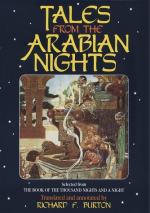The other story referred to is No. xx of Miss Stokes’ “Indian Fairy Tales,” which Mr. Coote could not have read, else he would not have been at the trouble to maintain it was impossible that Galland derived his tale from it: “so long,” says he, “as that story remained in the country of its birth— India—it was absolutely inaccessible to him, for great traveller as he was, he never visited that far-off portion of the East.” The fact is, this Hindu story only resembles Galland’s, and that remotely, in the opening portion Seven daughters of a poor man played daily under the shady trees in the king’s garden with the gardener’s daughter, and she used to say to them, “When I am married I shall have a son—such a beautiful boy as he will be has never been seen. He will have a moon on his forehead and a star on his chin,” and they all laughed at her. The king, having overheard what she so often repeated, married her, though he had already four wives. Then follows the golden bell affair again, with a kettledrum substituted. When the young queen is about to be confined her co-wives tell her it is the custom to bind the eyes of women in her condition, to which she submits, and after she has borne the wonderful boy she promised to do, they tell her she has been delivered of a stone. The king degraded her to the condition of a kitchen servant and never spoke to her. The nurse takes the baby in a box and buries it in the jungle. But the king’s dog had followed her, and when she went off he took the box out of the earth and swallowed the baby. Six months after the dog brings him up, caresses him and swallows him again. He does likewise at the end of the year, and the dog’s keeper, having seen all told the four wives. They say to the king the dog had torn their clothes, and he replies, he’ll have the brute shot to-morrow. The dog overhears this and runs off to the king’s cow; he induces her to save the child by swallowing him, and the cow consents. Next day the dog is shot, and so on: the cow is to be killed and induces the king’s horse to swallow the child, and so on.—There may have been originally some mystical signification attached to this part of the tale, but it has certainly no connection with our story.[FN#443]




